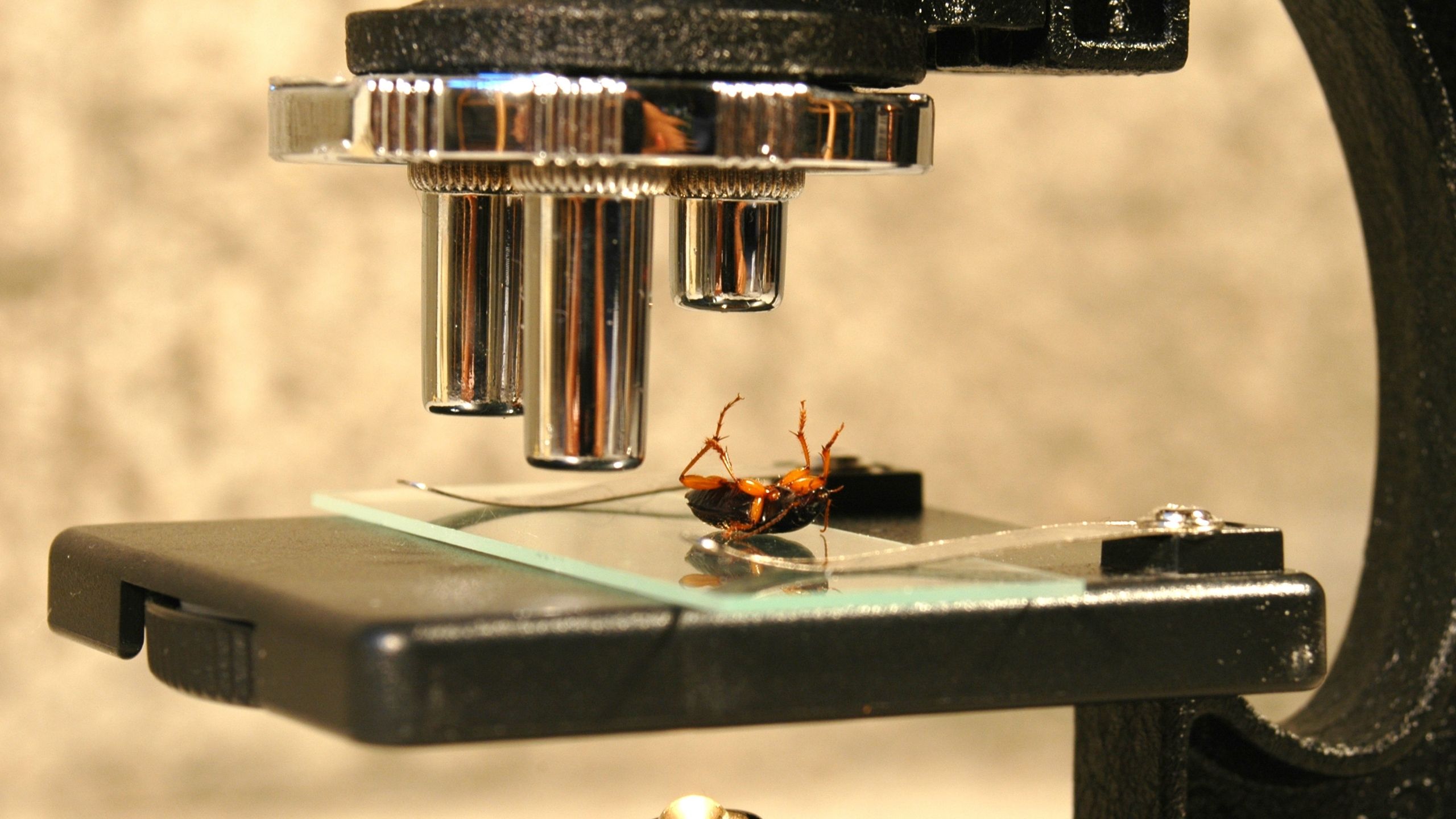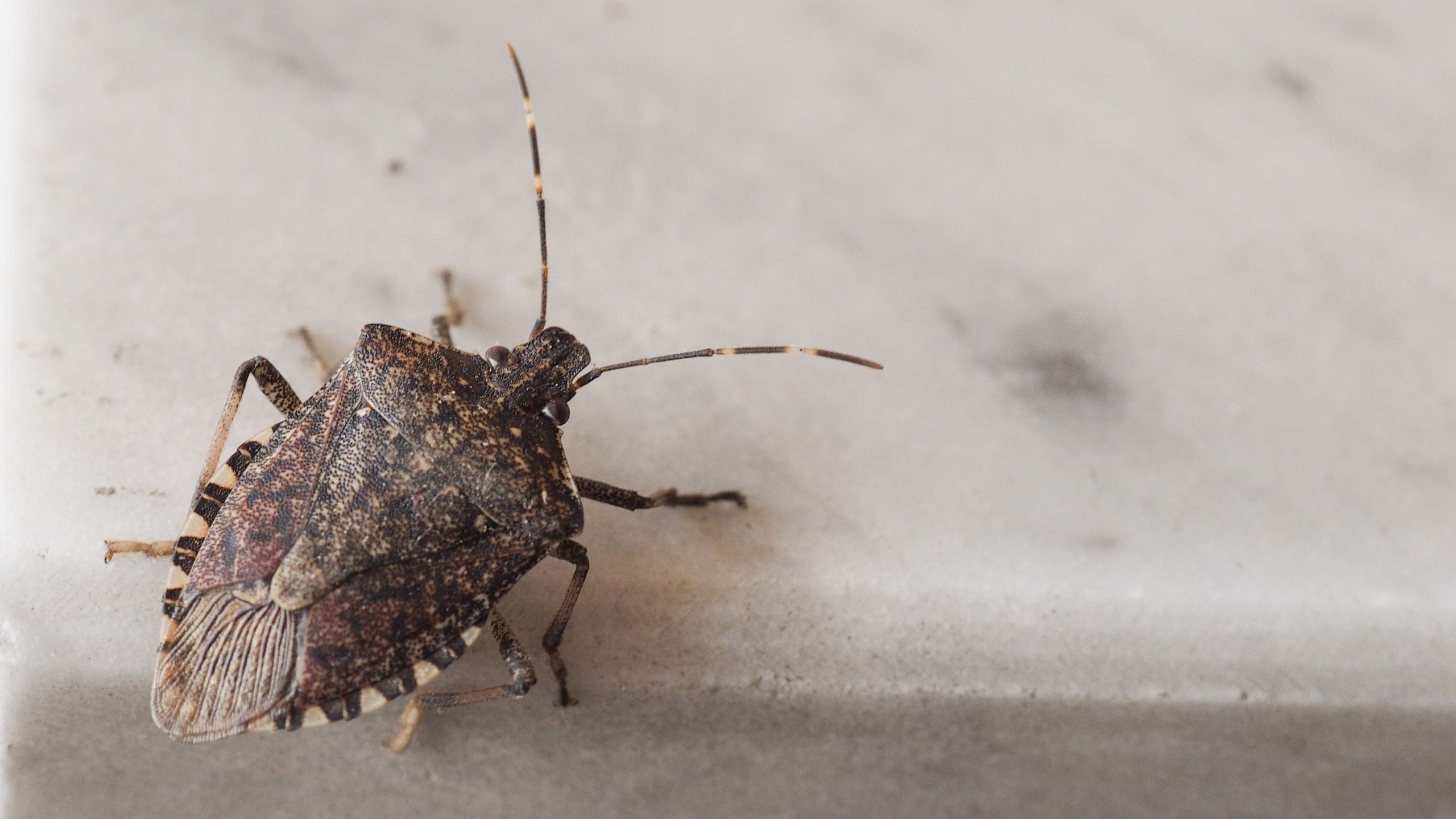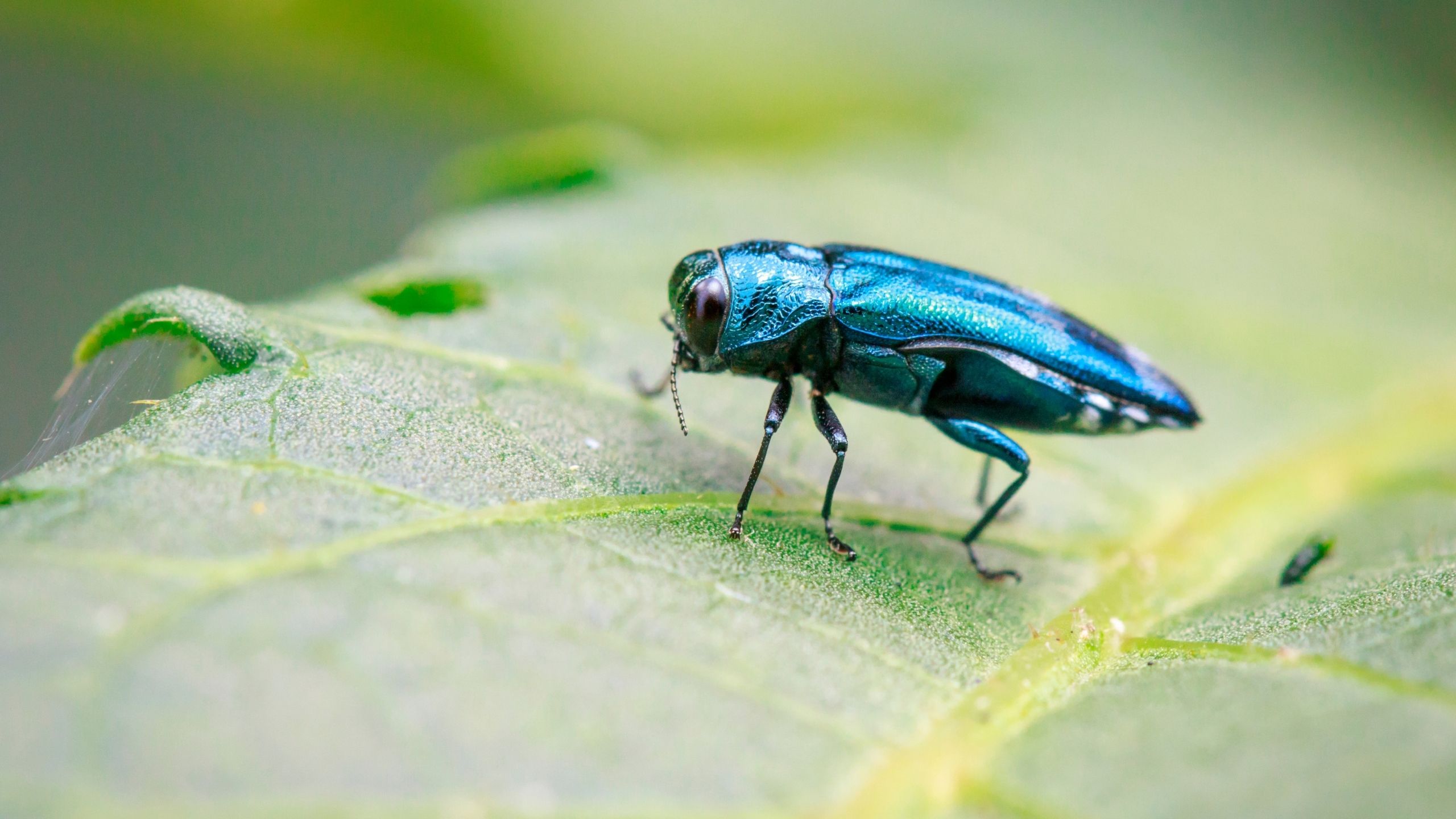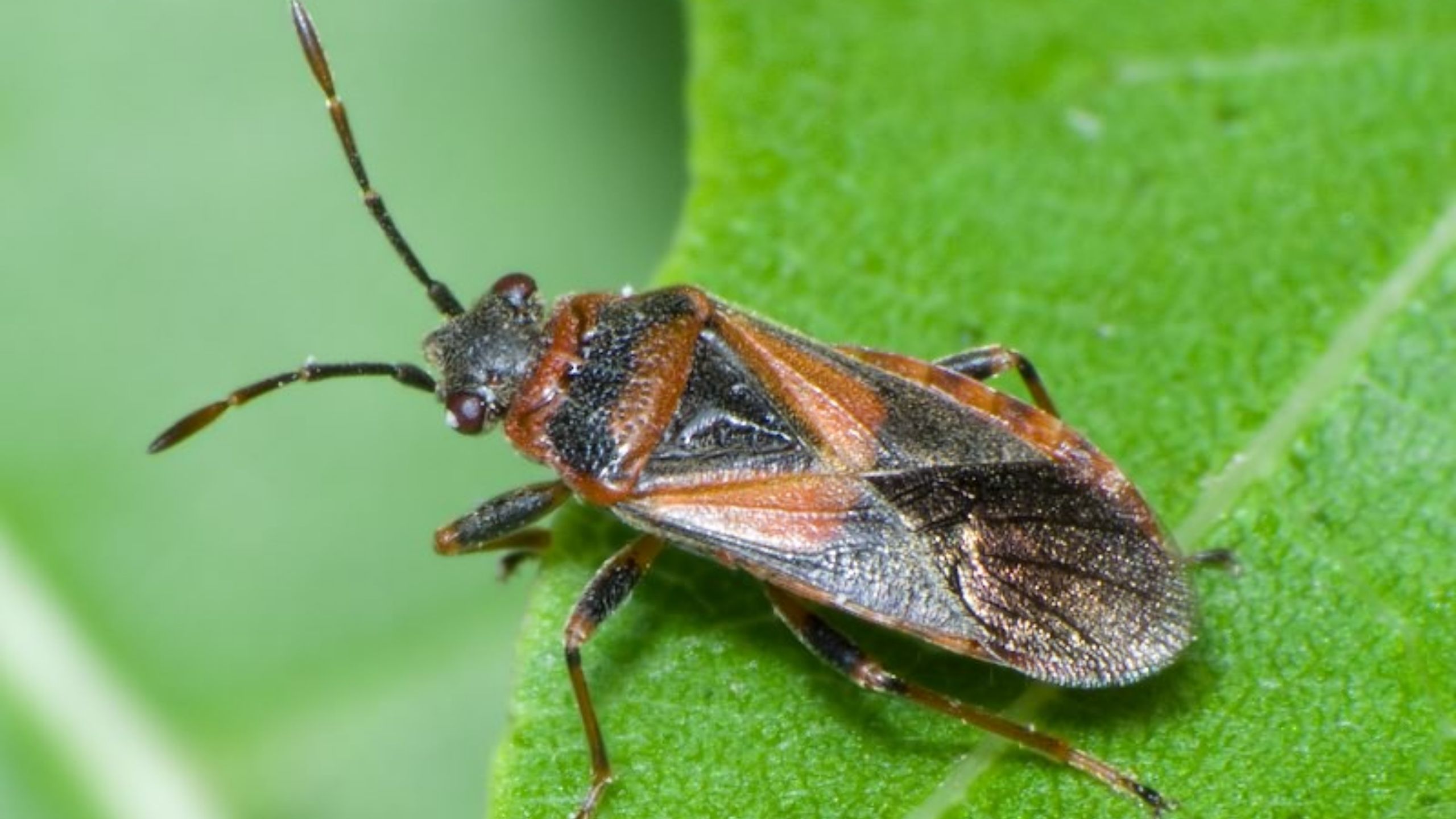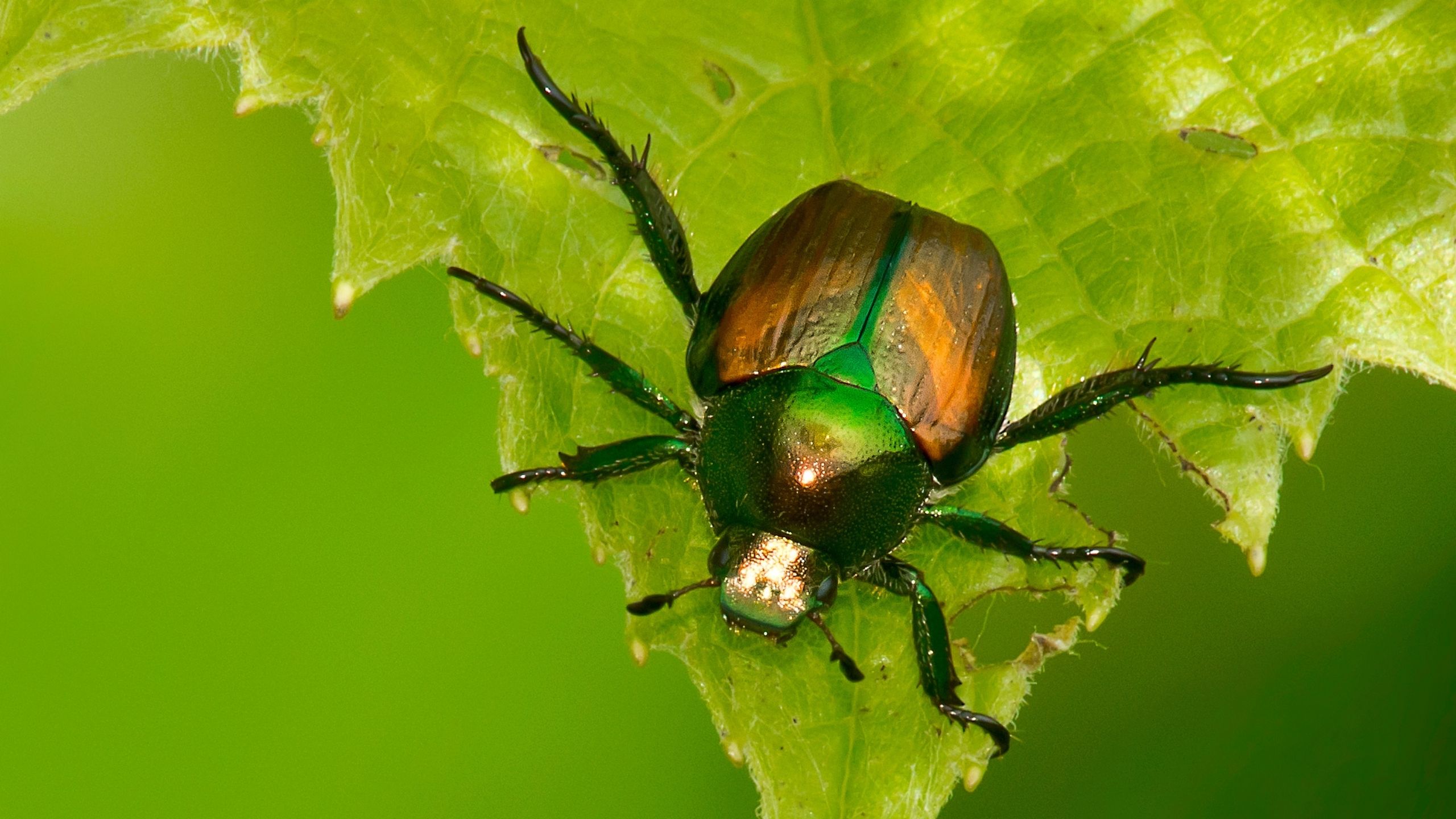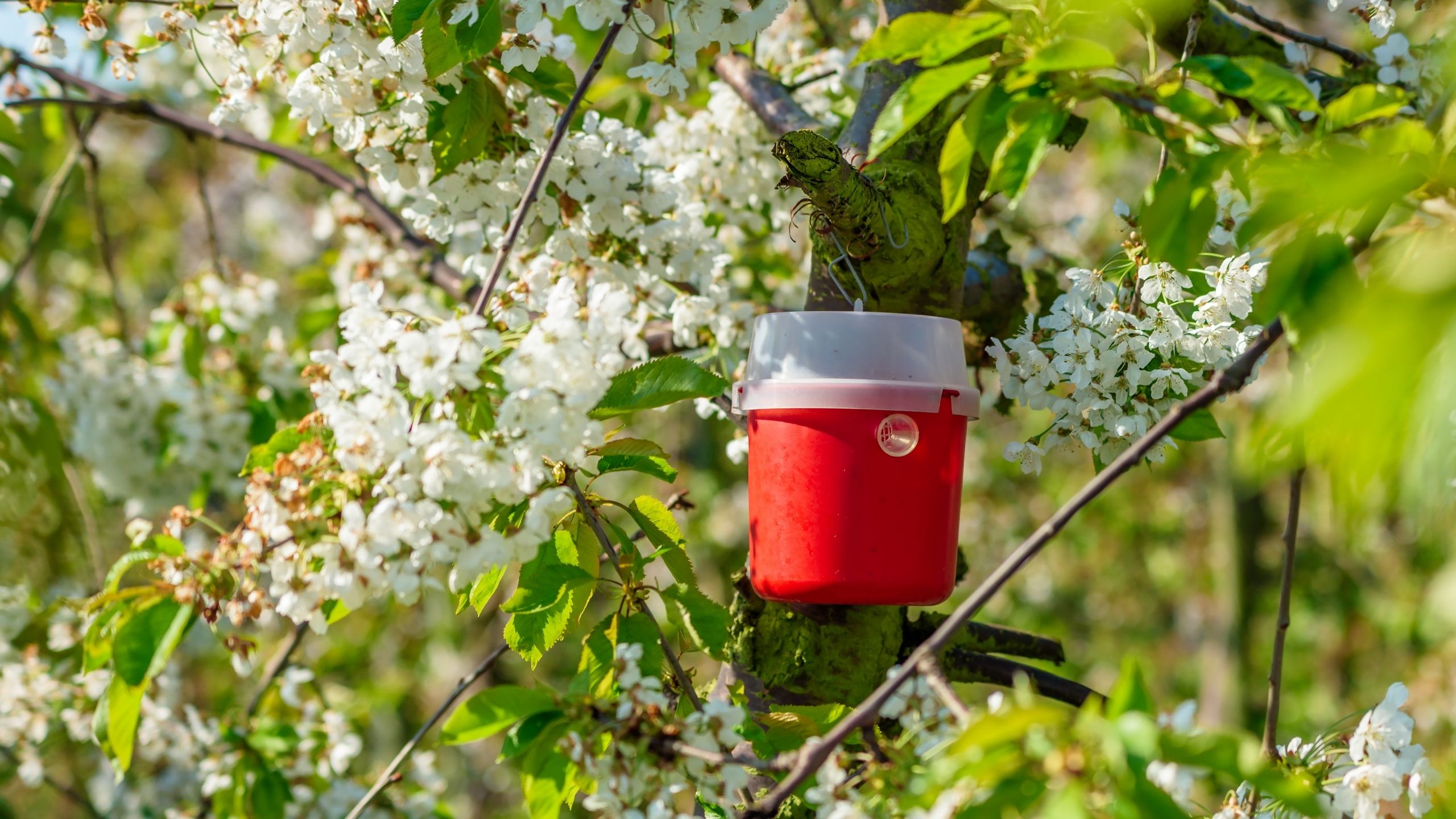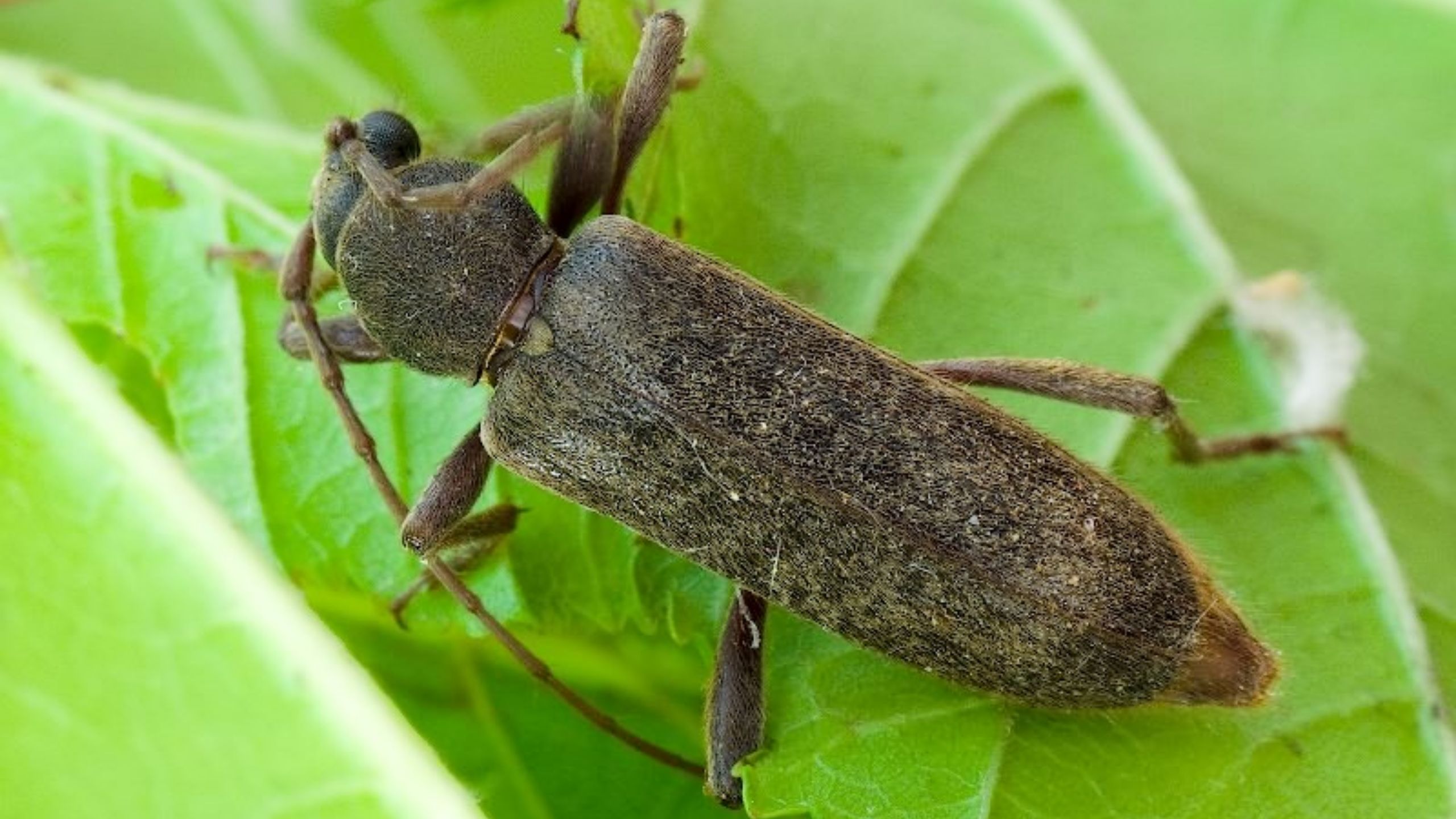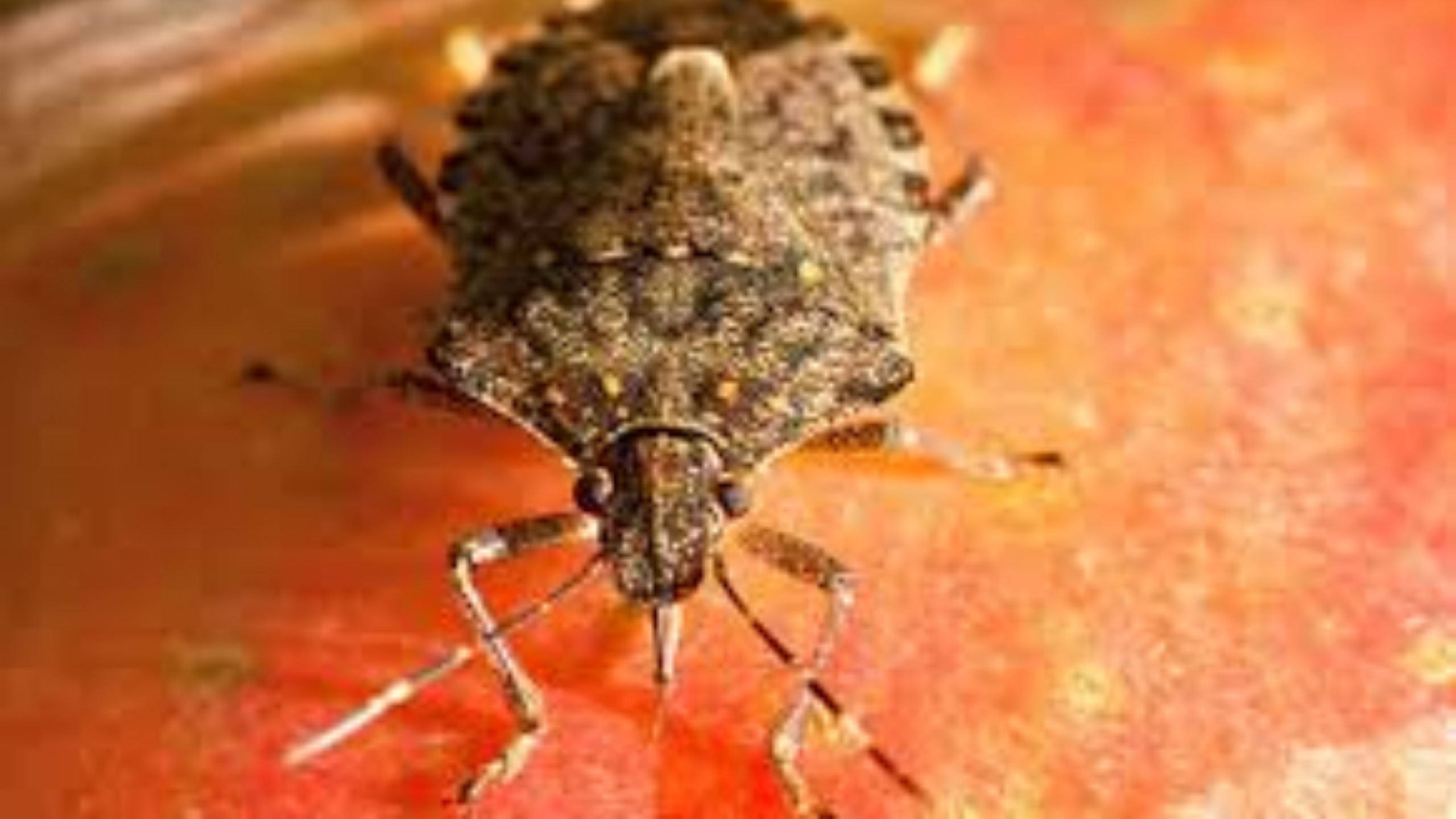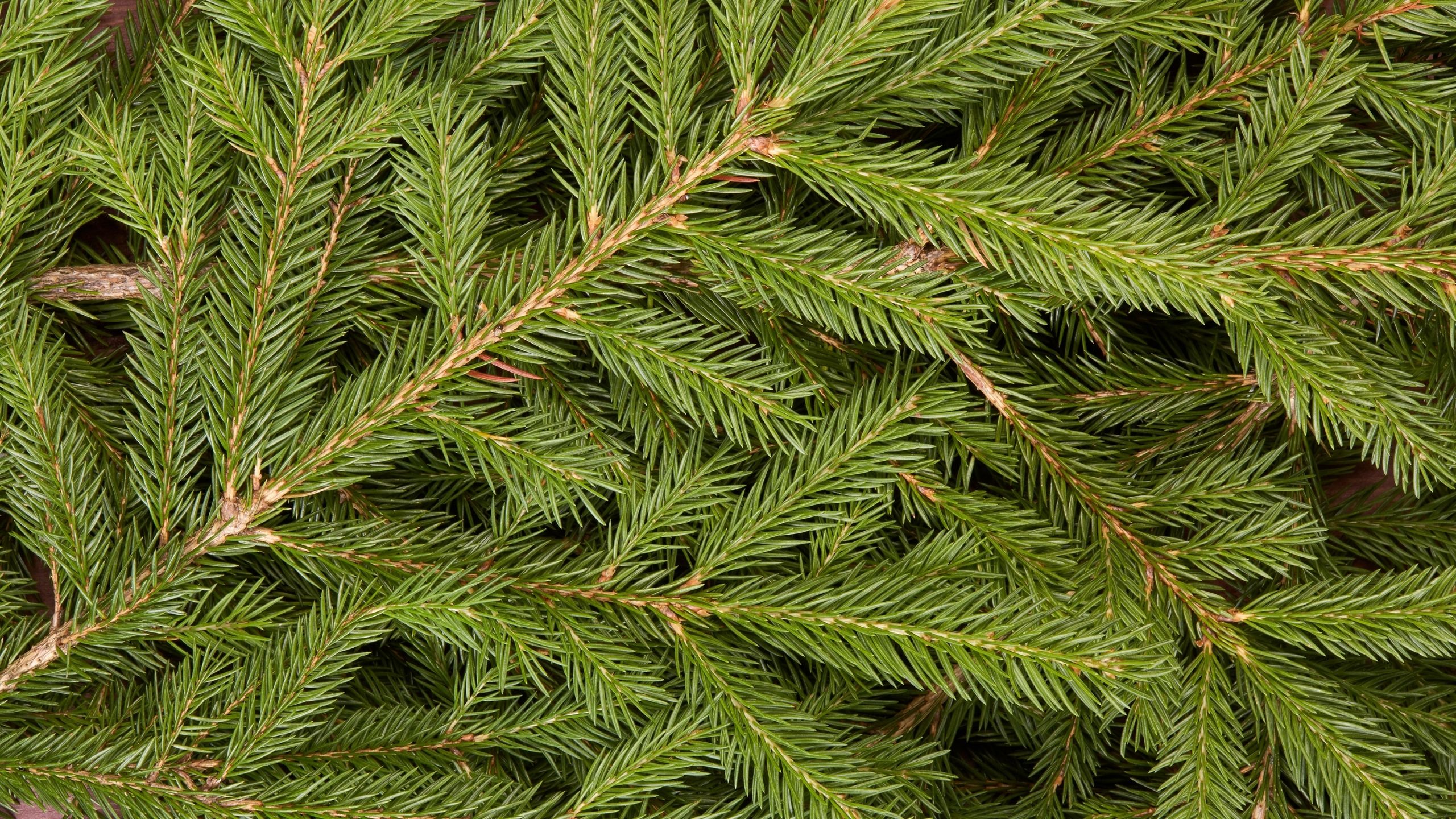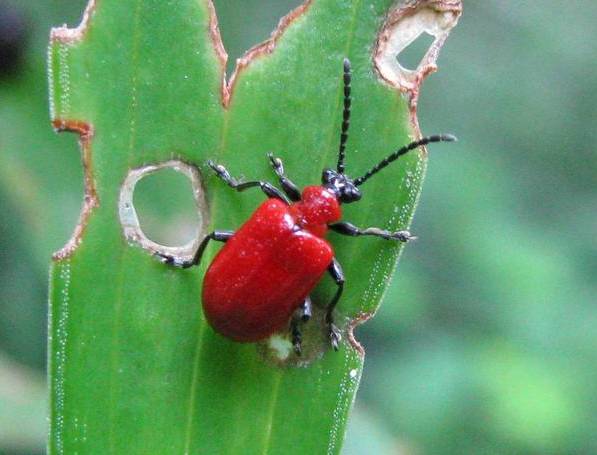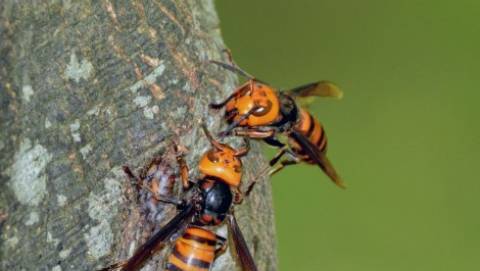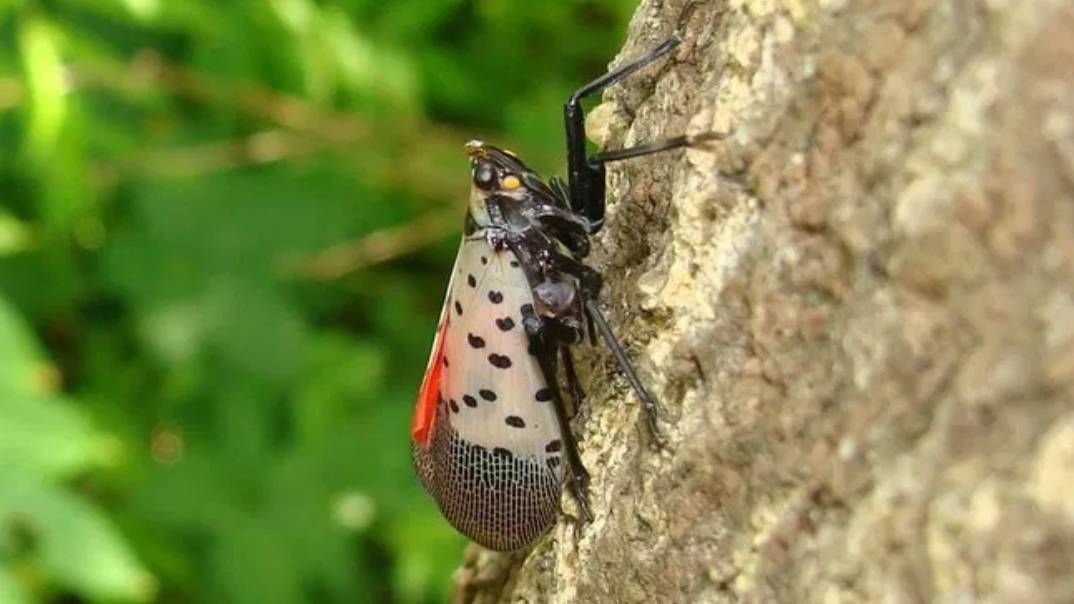Emerald Ash Borer
[Agrilus planipennis (Fairmaire)]
January 2023
Emily A. Parent, Lori R. Spears (No longer at USU), Ryan S. Davis (No longer at USU), and Ricardo A. Ramirez
Quick Facts
- The emerald ash borer (EAB) is an invasive pest that is considered to be one of the most destructive forest insects ever to invade the U.S.
- Larvae are the damaging life stage. They feed on the vascular tissues of the tree and eventually cause tree death.
- EAB is primarily spread to new areas by people moving wood from infested areas.
- New infestations are difficult to detect, and damage may not be obvious for years.
- An EAB infestation is nearly always fatal to the tree unless insecticides are used to protect trees.
- EAB has not yet been reported in Utah. To help prevent the spread of EAB, check ash trees for signs of infestation.

Fig. 1. Emerald Ash Borer Adult Feeding on an Ash Leaf. Image courtesy of Debbie Miller, USDA Forest Service, www.bugwood.org.
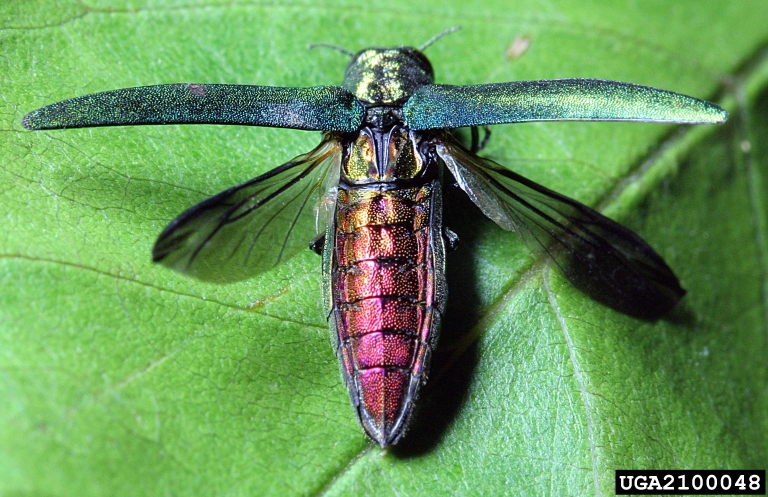
Fig. 2. Adults Have a Copper-Red or Purple Abdomen. Image courtesy of David Cappaert, Michigan State University, www.bugwood.org..
Emerald ash borer (EAB) (Order: Coleoptera: Family Buprestidae) (Figs. 1 and 2) is an invasive wood-boring insect that infests true ash species (Fraxinus spp.). EAB is native to parts of China, Korea, Japan, Taiwan, and small areas of Russia and Mongolia. It was first discovered in North America in June 2002 near Detroit, Michigan and Windsor, Ontario, Canada, and is thought to have arrived to North America via infested wood packing material. EAB is generally established in an area for several years before it is detected and can spread over large areas through active flight and human-mediated dispersal.
Since arriving in North America, EAB has been found in nearly 40 states, as well as five Canadian provinces (Ontario, Quebec, New Brunswick, Nova Scotia, and Manitoba), killing tens of millions of ash trees. Since 2013, the westernmost occurrence of this insect was Colorado; however, in June of 2022, EAB was found in Forest Grove, Oregon. If EAB were to be introduced and established in Utah, it poses a serious threat to the state’s ash trees. Ash comprises up to 30% of the urban canopy in many Utah communities, so EAB’s presence would make a noticeable impact. EAB infestations may have contributed to five ash tree species (F. americana, F. nigra, F. pennsylvanica, F. profunda, and F. quadrangulata) being classified as critically endangered, one step away from extinction, and one (F. caroliniana) as endangered according to the International Union for Conservation of Nature (IUCN) Red List. If you suspect EAB in Utah, contact the https://extension.usu.edu/pests/uppdl/index or the Insect and Pest Program at the Utah Department of Agriculture and Food.
While EAB poses no direct threat to humans, research has found that as ash trees vanished in areas infested with EAB, there was an increased number of deaths from cardiovascular and lower respiratory illnesses. Trees help to reduce stress, provide more opportunities for physical activity, and improve air quality, among other health benefits.
Description
EAB has four distinct life-stages: feeding adult, egg, feeding larva, and non-feeding pupa.
Adults are small (about 1/2 inch long and 1/8 inch wide), metallic green-colored beetles with a bronze head, a flattened body, short sawtoothed antennae, a rounded belly, and an iridescent purple abdomen hidden beneath their forewings. They are bullet-shaped and lack a defined waist (Figs. 1–3). Males and females are similar in appearance.
Eggs oval to round, very small (< 1/16 inch), and nearly impossible to locate on bark or in bark crevices where they are deposited. Newly deposited eggs are cream-colored but turn amber as they develop (Fig. 3).
Larvae are cream-colored with 10 abdominal segments and a flattened abdomen. Mature larvae reach a length of about 1 inch, are tapeworm-like in appearance, and have a pair of brown, pincer-like appendages on the last abdominal segment (Fig. 3). Their brown head is mostly retracted, but the mouthparts are visible externally. As larvae mature, they excavate a tiny chamber and curve back on themselves forming a J-shape.
Pupae are initially creamy white, but their body begins to darken as they develop (Fig. 3). They have the characteristic shape of the adult, with short saw-toothed antennae and a blunt spine at the tip of the last abdominal segment.
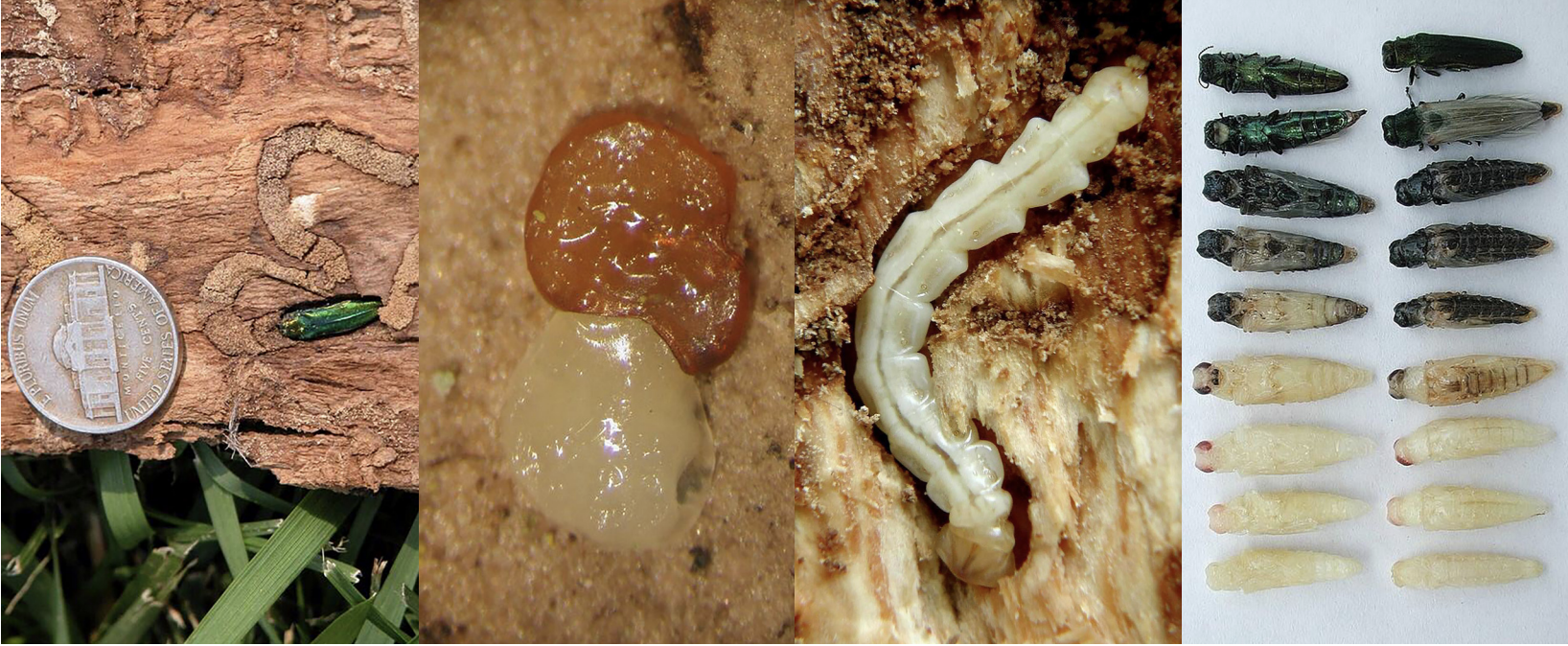
Fig. 3. Emerald Ash Borer Life Stages (from left to right): Adult, Eggs, Larva, and Pupae (with adults on the top). Image courtesy of Eric R. Day, Virginia Polytechnic Institute and State University, www.bugwood.org; Debbie Miller, USDA Forest Service, www.bugwood.org; David Cappaert, Michigan State University, www.bugwood.org.
Life History
In North America, EAB completes its life cycle in 1-2 years, depending upon the local environment, i.e., EAB develops more slowly in cold climates with short growing seasons.
EAB spends the winter as a larva or pre-pupa in a tiny chamber excavated in the sapwood, pupates in the spring, and adults begin emerging when degree-day (DD) accumulations reach 400–500 DD (using a base temperature of 50 °F), which can occur as early as mid-April in southern Utah or mid-May in northern Utah. Peak emergence is at 900 to 1,100 DDs (mid to late July)(visit Utah TRAPS for DD information).
Adults typically live 3-6 weeks and will feed on ash leaves for 1-2 weeks before mating. Adult feeding causes little damage. Mated females can produce hundreds of eggs during their lifetime. Eggs may be laid in groups or individually. Research has shown that at least 70% of adults lay their eggs on ash trees within 330 feet from where they emerged. After the eggs hatch (2–3 weeks later), the larvae bore into the phloem and cambium layers of the tree and then pass through four larval stages before overwintering.
Symptoms and Damage
Early infestations are difficult to detect since EAB adults usually infest tree crowns before working their way down to the trunk of the tree. Signs and symptoms of EAB include bark splits, thinning or dieback of the tree’s canopy (Fig. 4), increased woodpecker feeding, and sucker shoots (epicormic growth) at the tree’s base or at the base of large, dead branches. In addition, EAB adults leave behind distinctive D-shaped exit holes (1/8 inch wide) when they emerge from trees in the spring (Fig. 4).
When the larvae chew through the bark into the phloem and sapwood, they create serpentine-shaped and frass-filled (mix of sawdust and excrement) galleries that may be seen by peeling the bark away from the tree (Fig. 5). These galleries disrupt the flow of nutrients and water and starve the tree. Larval galleries curve at near right angles so that the tunnel length, as measured in a straight line from start to end, is less than half of the actual total tunnel distance. Note: any serpentine gallery in an ash tree should be suspect. Galleries increase in width as larvae feed and grow and are more common in the upper canopy in newly infested trees. Galleries can be found lower on the trunk as the infestation progresses.
In Colorado, researchers have found that ash trees infested with EAB have leaves that are smaller and lighter in color compared to normal ash leaves. When EAB densities are high, small trees can die within 1–2 years of becoming infested, whereas large trees can be killed within 3–4 years.
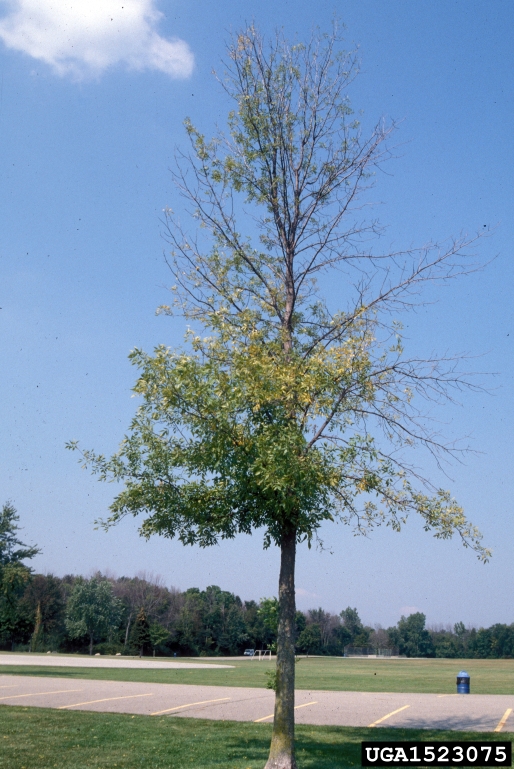
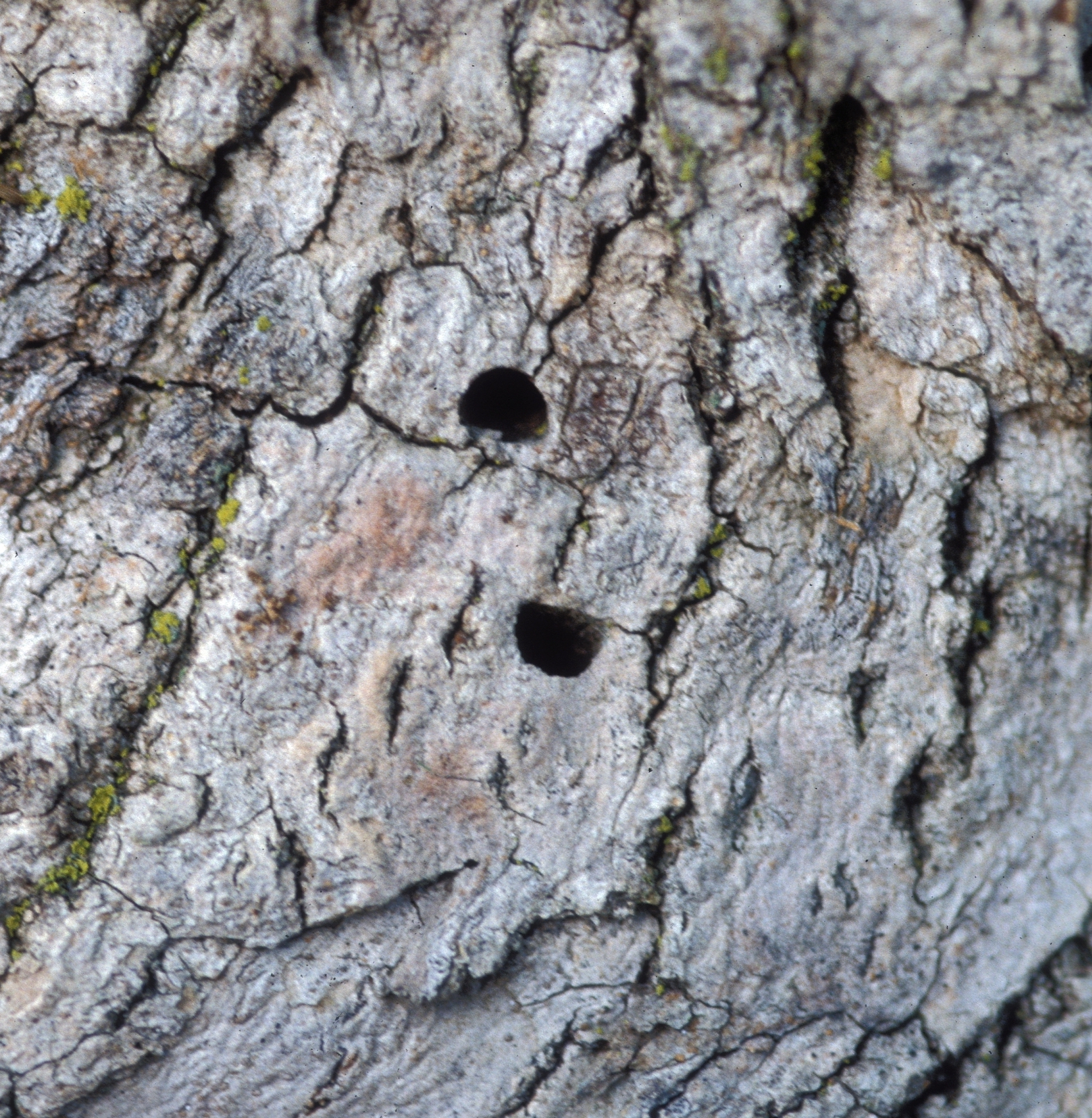
Fig. 4. Canopy Dieback (left) and Adult Emergence Holes (right). Image courtesy of Daniel Herms, Ohio State University, www. bugwood.org.
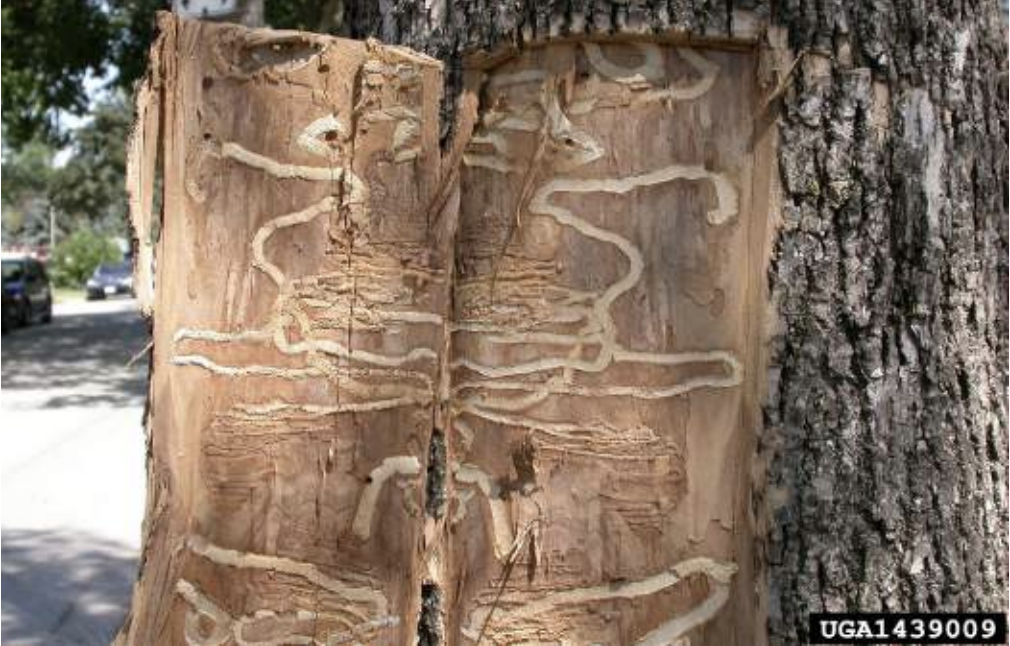
Fig. 5. Serpentine Channels Caused by Emerald Ash Borer Larvae. Image courtesy of Edward Czerwinski, Ontario Ministry of Natural Resources, www.bugwood.org.
Host Plants
EAB attacks true ash (Fraxinus) species, including white (F. americana), green (F. pennsylvanica), and black (F. nigra) ash, all of which are native to parts of the Eastern U.S. These species are important to Utah landscapes as well as the single-leaf ash ()F. anomala) and velvet ash ()F. velutina), which are native to arid regions of Utah and the Southwest. Although EAB was thought to specialize on ash, it has been found infesting white fringe trees ()Chionanthus virginicus) in Ohio and Illinois. This may indicate that EAB has a wider host range than originally thought, or that it is adapting to utilize new hosts. Both ash and fringe trees are members of the olive family (Oleaceae). Mountain ash (Sorbus) spp.) is not a true ash species and will not be affected by EAB. Both healthy and unhealthy trees can be attacked. Some characteristics for identifying ash trees include:
- Opposite branching: Branches and buds are directly across from each other. Keep in mind, however, that buds and limbs die, so not every branch will have an opposite mate.
- Compound leaves: Ash leaves are compound with 5-11 leaflets (Fig. 6). Leaflet margins may be smooth or toothed. Box elder (Acer negundo) is another oppositely branched tree common in Utah but almost always has 3-5 leaflets.
- Seeds: Seeds are oar-shaped, typically occur in clusters, and hang on the tree until fall or early winter (Fig. 6).
- Bark: The bark of young trees is smooth, whereas mature trees have diamond-shaped ridges (Fig. 7).

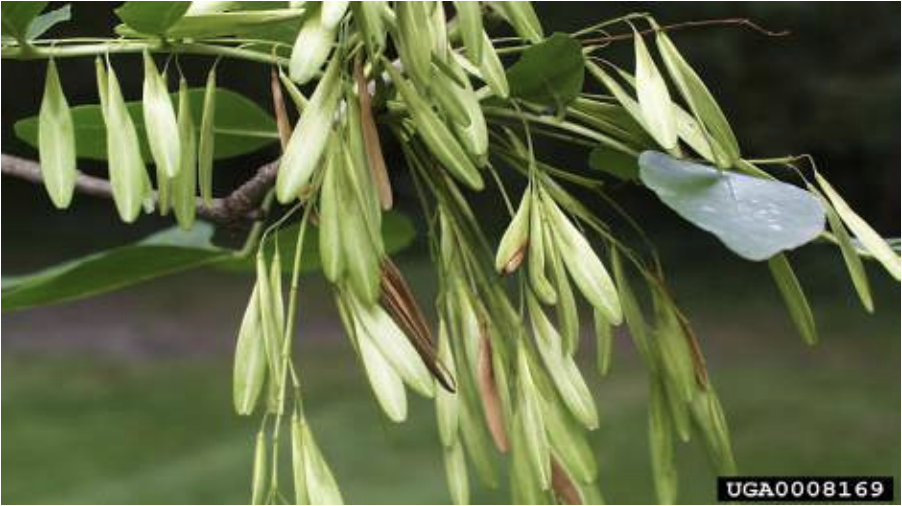
Fig. 6. Ash Leaf with 7 Leaflets (left) and Ash Seeds (right) leaf with 7 leaflets. Image courtesy of Keith Kanoti, Maine Forest Service, www.bugwood. org; Paul Wray, Iowa State University, www.bugwood.org.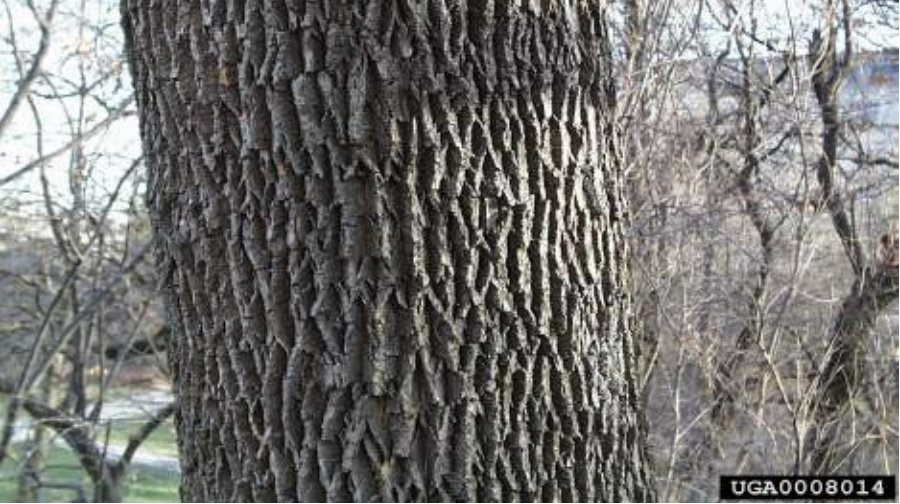
Fig. 7. Mature Ash Trees Have Diamond-Shaped Ridges. Image courtesy of Paul Wray, Iowa State University, www.bugwood. org.
Monitoring
There are a number of monitoring techniques for detecting EAB, including traps, branch sampling, and girdled (trap) trees. Some of these may be suitable for homeowners.
Green lindgren funnel traps (Fig. 8) are used during statewide detection trapping programs but are not readily available to the public. Traps are baited with a lure made of oils that mimic chemicals released by stressed ash to attract EAB.
Branch sampling is recommended for both homeowners and survey personnel and is most valuable in urban and other high-risk areas. Collect branches in the fall when larvae are more easily detected. Use the following steps to inspect branches:
1. Choose an ash tree that is 20 to 60 feet tall with a large, open canopy.
2. Collect two branches (1–4 inches in diameter) from the middle canopy. Remove branches using proper pruning safety procedures and precautions.
3. Remove lateral branches.
4. Carefully use a drawknife to peel back the bark in thin strips.
5. Examine the branches for EAB galleries and/or larvae.
Girdled trees are considered effective EAB detection and management tools. Trees are girdled by removing the entire bark and cambium layer around the circumference of the trunk (Fig. 9). The tree is then forced into a state of stress and, therefore, highly attractive to EAB. In areas where EAB has not been detected, the tree is removed at the end of the season and remaining bark is stripped to check for EAB galleries and larvae. In areas known to be infested with EAB, girdled trees are removed within a few weeks and destroyed, and a large number of EAB larvae are destroyed with it. This is known as a “population sink.”
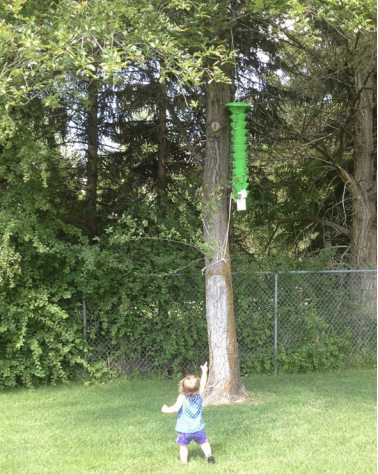
Fig. 8. Green Lindgren Funnel Trap. Image courtesy of Ryan Davis, U.S. Forest Service.
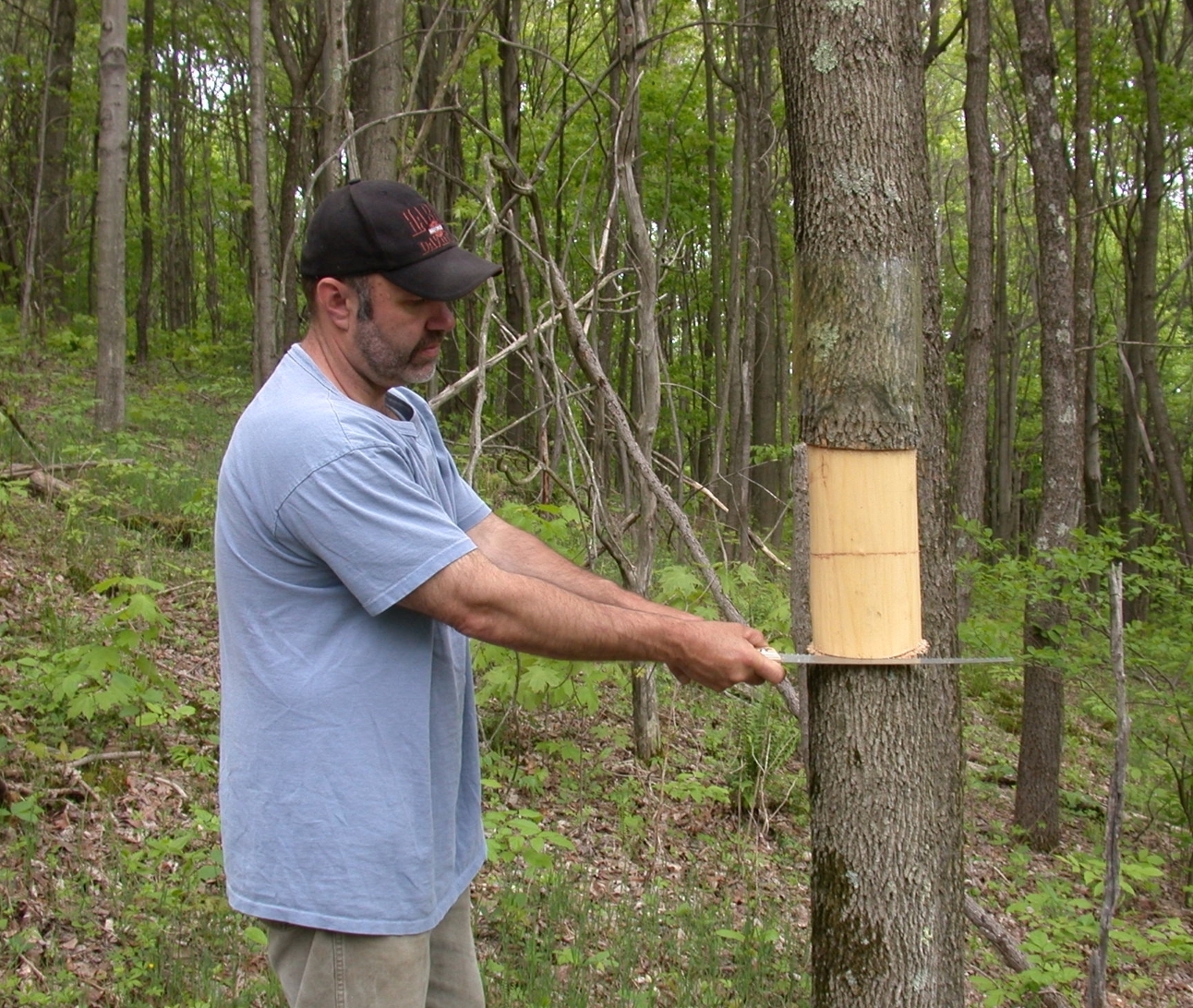
Fig. 9. Girdled Ash Tree. Image courtesy of Pennsylvania Department of Conservation and Natural Resources - Forestry, Bugwood.org.
Look-alikes
There are several insects that look similar to EAB and other types of insects that tunnel in ash trees. For example, the honeylocust (Agrilus difficilis) and bronze birch (A. anxius) borers are closely related to EAB but are pests of honeylocust and birch, respectively. Adults emerge from D-shaped exit holes and the larvae look similar to EAB larvae. Unlike EAB, adult honeylocust borers have black bodies with white or yellow spots along the abdomen, and bronze birch borers are mostly bronze (Fig 10). Further, the lilac ash borer (Podosesia syringae) is a clearwing moth that, as an adult, mimics a paper wasp, but the damage it causes to ash trees is often mistaken as signs of EAB. Lilac ash borer larvae are caterpillarlike, and when the adult moth emerges from pupation, the pupal skin often extrudes from an exit hole that is irregularly round and about 1/4 inch in diameter (Fig. 11). EAB larvae are tapeworm-like (Fig. 3) and the young adult sheds its pupal skin in a chamber within the tree.
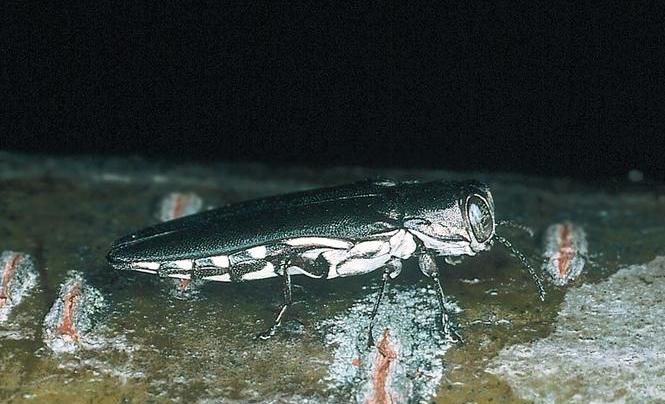

Fig. 10. Honeylocust Borers (left) and Bronze Birch Borers (right) Are Closely Related to Emerald Ash Borer. Image courtesy of Kansas Department of Agriculture, www. bugwood.org; Steven Katovich, USDA Forest Service, www.bugwood.org.
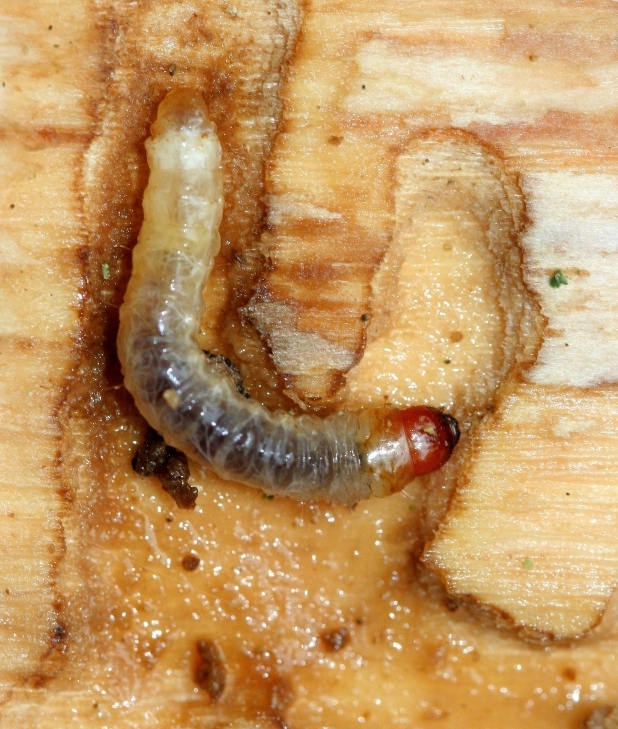
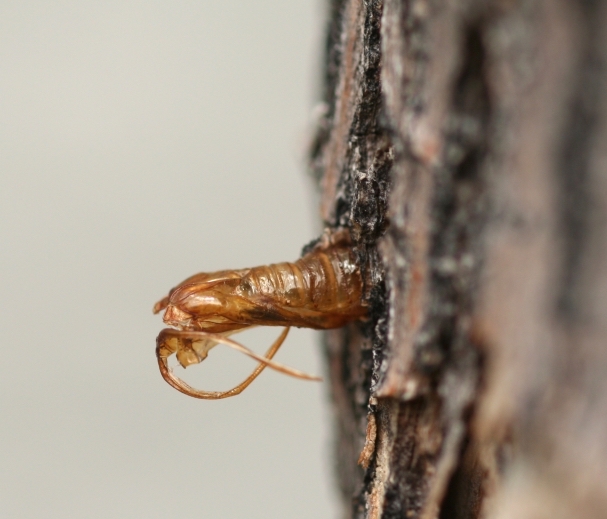
Fig. 11. Lilac Ash Borer Larva (left) and Pupal Skin (right). Image courtesy of David Cappaert, Michigan State University, www.bugwood.org; Whitney Cranshaw, Colorado State University.
Nonchemical Control
To help suppress and prevent the further spread of EAB, federal officials from the U.S. Department of Agriculture’s Animal and Plant Health Inspection Service (USDA APHIS) release biocontrol agents (i.e., parasitoid wasps) in areas known to be infested. The wasps lay eggs inside EAB eggs or larvae, and the wasp larvae consume the egg or larval contents, effectively killing the developing beetle. Biocontrol is seen as the most sustainable and long-term approach to limiting EAB population growth. In addition, the Utah Department of Agriculture and Food (UDAF) implemented a state quarantine in 2021 that restricts beetle movement in any living stage, as well as ash trees, firewood, green waste, and other articles that present an insect-spreading hazard. Further, since EAB and other forest pests can be transported to new areas on firewood, UDAF also implemented a state firewood quarantine, which prohibits firewood imports from high-risk areas of the U.S. and Canada, unless the shipment is certified as heat-treated or meets other precautionary standards set forth by the state.
Buying local firewood is the simplest way to ensure that you are not moving invasive species to new areas. If you purchase firewood, check the label to see where it originated. If it was harvested in Utah or heat-treated, then the product meets the quarantine. If you have already moved firewood into the state from a quarantined area, then it is important that you burn it immediately. Make sure to collect all pieces of wood and rake up any dropped leaves, bark, twigs, or other debris and burn them as well. Do not leave any wood behind.
Finally, do not include ash in new plantings. Remove any ash that are in suboptimal health or located in poor sites. The website https://treebrowser.org/ can be used to select a variety of ash alternatives.
Chemical Control
EAB has not been detected in Utah, so there is no current need for chemical control of this insect. If EAB becomes established in Utah, control can be achieved using registered insecticides (Table 1). Insecticides are not 100% effective due the inherent difficulty of managing insects under tree bark, and trees with greater than 50% crown dieback have a small chance for survival. Infested trees treated with a systemic insecticide may take a year or more to show improvement in overall tree health. Treatments may need to be repeated annually or biannually to protect trees during EAB invasions. There are a few ways to apply insecticide products, including soil/root drenches, trunk injections, and bark and foliage sprays, but the choice of product needs to match the appropriate application method. For homeowners, a soil drench of systemic insecticides is the best choice, but efficacy can be variable and depends on tree size (more effective on smaller trees) and beetle pressure.
Table 1. Examples of insecticides for Emerald Ash Borer control.*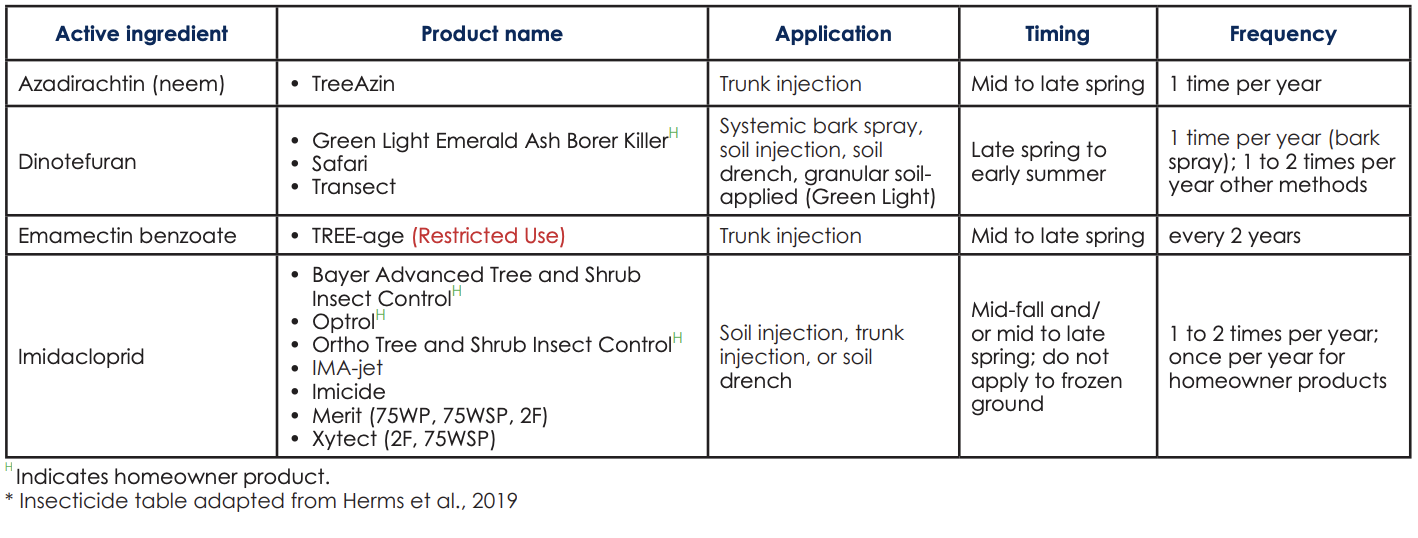
Help Stop the Spread of EAB
EAB is primarily spread by movement of infested wood. You can help stop the spread of EAB by not transporting firewood and by burning wood where you buy it. If you have ash trees in your yard, please check them periodically for signs of EAB infestation.
References and Further Reading
- Animal and Plant Health Inspection Service (APHIS). (2013). Emerald ash borer program manual, Agrilus planipennis (Fairmaire). U.S. Department of Agriculture (USDA).
- Cappaert, D., G. McCullough, T.M. Poland, and N.W. Siegert. 2005. Emerald ash borer in North America: a research and regulatory challenge. American Entomologist 51:152-165.
- Donovan, G. H., Butry, D. T., Michael, Y. L., Prestemon, J. P., Liebhold, A. M., Gatziolis, D., & Mao, M. Y. (2013). The relationship between trees and human health: Evidence from the spread of the emerald ash borer. American Journal of Preventive Medicine, 44, 139–145.
- Herms, D. A. & McCullough, D. G. (2014). Emerald ash borer invasion of North America: History, biology, ecology, impacts, and management. Annual Review of Entomology, 59, 13–30.
- Herms, D. A., McCullough, D. G., Clifford, C. S., Smitley, D. R., Miller, F. D., & Cranshaw, W. (2019). Insecticide options for protecting ash trees from emerald ash borer. North Central IPM Center Bulletin, 3, 16.
- McCullough, D.G., N.R. Schneeberger, and S.A. Katovich. 2008. Pest Alert: Emerald Ash Borer. United States Department of Agriculture, Forest Service, Northeastern Area State and Private Forestry. Newton Square, Pennsylvania. NA-PR-02-04.
- Oregon State University Extension Service. (2022). Emerald ash borer detected in Oregon: Be alert and report sightings. Oregon State University.
- Rebek, E. and M. Wilson. 2005. Ash tree identification. Extension Bulletin E-2942. Michigan State University Extension.
- Rebek, K.A., E.J. Rebek, and D.G. McCullough. 2005. Don’t be fooled by look alikes! Extension Bulletin E-2944. Michigan State University.
- Red List. (2022). The IUCN Red List of threatened species. International Union for Conservation of Nature
- Wilson, M. and E. Rebek. 2005. Signs and symptoms of the emerald ash borer. Extension Bulletin E-2938. Michigan State University.
Public outreach material can be found on several sites including dontmovefirewood.org, emeraldashborer.info, and hungrypests.com.
Related Research



